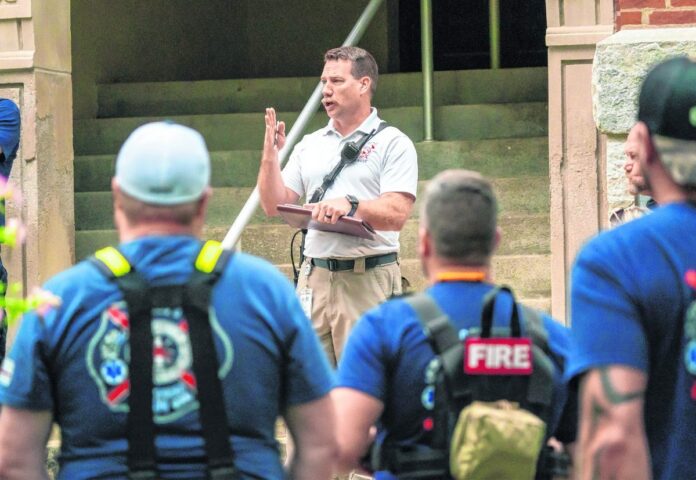
A unique active shooter training brought emergency medical services personnel from around the county together Saturday at Franklin College to practice responding as a team.
Firefighters, EMS and police officers from various agencies prepare individually for all kinds of emergency situations. This training, though, brought all the parties together to practice a coordinated response to a potential active shooter situation.
The idea came from Amity Volunteer Fire Department in the aftermath of the FedEx shooting in Indianapolis, said Brandon Burton, Amity’s training coordinator. The goal was to get agencies in the county on the same page and ready to work together if such an incident were to occur in Johnson County, he said.
The exercise involved firefighters and EMS from Amity, Bargersville, Franklin, Nineveh, Trafalgar, Whiteland and White River Township fire departments, along with the Franklin Police Department, Johnson County Sheriff’s Office and Johnson County Central Communications.
White River Township Fire Chief Jeremy Pell took on the role of incident commander at the scene.
“What we’ve learned from all of these active shooter incidents is that if we get in the same room, on the same training ground and actually train together at the same time, our operations become much smoother and more efficient,” Pell said.
The training is especially helpful to firefighters and EMS who aren’t used to the idea of going into an active crime scene to find victims, said Mike Pruitt, Bargersville’s deputy fire chief.
As part of this weekend’s exercise, police secured a scene and apprehended a volunteer posing as an active shooter.
Then EMS went inside the building with police escorts to find and triage the volunteers posing as shooting victims, and get them to Johnson Memorial Hospital for treatment, about a 2-mile haul down Jefferson Street through downtown.
At the hospital, EMS practiced handing off the victims to emergency room staff, who then simulated prioritizing care for the most severely injured volunteers.
Going into a still-active scene is something EMS did not used to do, Pruitt said. But lessons from previous active shooter incidents have taught first responders that it is a step that ultimately saves lives, he said.
“When we look back to Columbine (in 1999 in Colorado) there was a lot of negotiating and sit back and wait, but there were people in there bleeding out. Police changed their tactics and we changed our tactics,” Pruitt said. “Now, the first officer on the scene is going in there. Our job is, as soon as he eliminates that threat, to take our personnel in there with law enforcement and remove the people who are injured from the building as quickly as possible.”
Another goal of the training was to make it as realistic as possible, officials said. Still, the training was on a much smaller scale than what would likely play out in real life, but those assembled gained valuable experience they can put into action if the need arises, they said.
“We hope it never happens, but we spend all this extra work and we come together as one team because we never want to look back and say we weren’t prepared for this,” Pell said.
To help first responders if tragedy strikes close to home, Pruitt asks the public to think about the Run, Hide, Strike strategy. Anyone who can run away should; anyone who can’t run should hide; and striking the assailant should only be done as a last resort, he said.
The public can also take a Stop The Bleed training course.
If a first responder can’t get into a scene quickly, any member of the public could do their part to save a life by applying pressure to stop the bleeding. Stopping the bleeding can often mean the difference between life and death for a victim who has a gunshot wound, Pruitt said.
To find a Stop The Bleed class, visit stopthebleed.org. Local classes are offered at the Franciscan Health Education Center in Greenwood.




